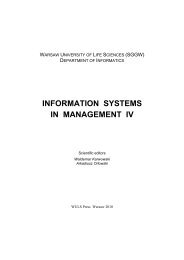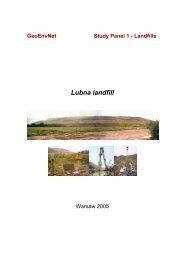ACTA SCIENTIARUM POLONORUM - SGGW
ACTA SCIENTIARUM POLONORUM - SGGW
ACTA SCIENTIARUM POLONORUM - SGGW
Create successful ePaper yourself
Turn your PDF publications into a flip-book with our unique Google optimized e-Paper software.
8 A. Gawrońska, S. Paszkowskinumber of insured in SII in 2008 significantly exceeded the number of insured in ASIF(over nine times). In both systems, the number of pensions was lower than the number ofinsured persons. This situation should be regarded as favorable, because there are morecontributors than the recipients of benefits. However, it should be noted, that the ratioof the number of pensioners in relation to the number of insured persons in social insurancesystem amounted to 2.01, while in the case of benefits paid by ASIF, this factor wasequal to 1.07 (Table 1). A growing number of persons receiving agricultural pensions,with constant or declining number of paying the insurance premium will cause the pensionsystem of agricultural insurance to be more vulnerable to the reduction of revenuesfrom contributions.The provinces which stand out from others, as far as the average monthly number ofpensions from SII in 2008 is concerned, were: Śląskie and Mazowieckie. The numberof benefits in these regions was: 1127.7 thousand and 951.3 thousand appropriately, thatis over five times more than for example in Podlaskie (171.4 thousand). Also in thoseprovinces there were the highest number of insured persons. The lowest number of theaverage monthly number of pensions, workers’ pensions and the number of insured werecharacterizing such provinces as: Lubuskie, Opolskie and Podlaskie (Table 1).Average monthly number of pensions in total, paid by the Agricultural Social InsuranceFund in 2008 was 1477.7 thousand while the number of insured persons was 1574.4thousand (Table 1). The highest number of social security benefits from the agriculturalsocial insurance system was paid in provinces Mazowieckie and Lubelskie. These provinceswere also characterized by the highest number of insured (Table 1). Moreoverin such provinces as: Łódzkie, Małopolskie, Podlaskie and Wielkopolskie the averagemonthly number of pensions in the examined year exceeded 100 thousand. The lowestaverage monthly number of analyzed benefits and the number of insured were characterizingsuch regions as: Lubuskie, Opolskie and Zachodniopomorskie (Table 1).Analyzing the individual forms of social security benefits it is possible to concludethat in case of both social insurance system old-age pensions are the highest share of thewhole benefits. In turn survivor’s pensions, represented the smallest share. The attentionshould be paid to the fact that the survivor’s pensions from the agricultural insurance systemconstituted only 3.0% of the whole number of benefits, however that from SII – over17% (Figure 1). Such a large difference in the allocation of the survivors may be due tothe fact, that a large number of farmers also work outside agriculture, e.g. as a teachers,skilled workers or non-agricultural business owners. Such persons are normally subjectto social security insurance [Fedyszak-Radziejowska 2010]. Overload of professional responsibilities,poor working conditions are often conducive to cause an accident, diseasesand often death. Hence, in the case of the employee pension insurance, the share of paidsurvivors is higher than in that addressed to farmers agriculture. A small percentage ofsurvivors’ pensions paid under the Act on the social insurance for farmers may be alsocaused by relatively low age of farmers who apply for a pension.The average number of agricultural old-age pensions in total in 2008 was over fourtimes lover that the number of such pensions paid off from SII. In the case of disabilitypensions, ASIF paid over five time less that SII, whereas the survivors’ pensions – over29-times (Table 2).Acta Sci. Pol.
















